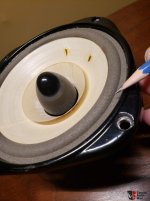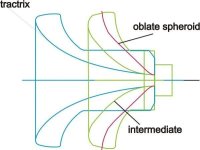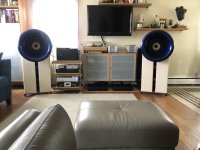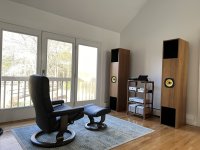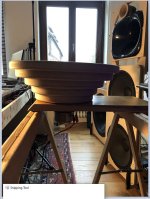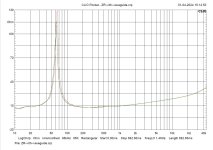Member
Joined 2009
Paid Member
I have a single Lowther A55 waiting for use but the question is somewhat generic - I've been looking around for inspiration and I see a lot of people have been happy putting a full range driver with whizzer cone into a front loaded horn. So I've been reading up on horn theory, and see how a front loaded horn works with a cone driver. But there's not much written about how a whizzer cone driver works in such a horn.
The popular tractrix profile, and other similar profiles usually require the horn to have quite some length in order to reproduce lower frequencies and this looks like a bad starting point to me for a whizzer cone as the high frequencies will be radiated into the walls of the throat and bounce around from there. Or the throat simply cuts off the higher frequencies altogether. I can see why some folk just cut off the whizzer cones and add a separate tweeter.
So it seems to me that only a shallow horn is practical if the whizzer cone h.f. sound is to be preserved. Then it's down to conical profiles for the most part, or oblate spheroid for better loading of the main cone.
Anybody looking into this ??
The popular tractrix profile, and other similar profiles usually require the horn to have quite some length in order to reproduce lower frequencies and this looks like a bad starting point to me for a whizzer cone as the high frequencies will be radiated into the walls of the throat and bounce around from there. Or the throat simply cuts off the higher frequencies altogether. I can see why some folk just cut off the whizzer cones and add a separate tweeter.
So it seems to me that only a shallow horn is practical if the whizzer cone h.f. sound is to be preserved. Then it's down to conical profiles for the most part, or oblate spheroid for better loading of the main cone.
Anybody looking into this ??
Attachments
A whizzer works in a big front loaded horn is just like if there was no horn.
A horn can load 3-4 octaves at most. So in big horns like the Lowther + Oris, the driver is horn loaded at teh low end but as ferequency rises it becomes a direct radiator. The whizzer doesn’t know anything about the horn.
The idea of the Oris (and similar) is to bring gain at the low frequency to better balance the driver which has a significntly rising response.
dave
A horn can load 3-4 octaves at most. So in big horns like the Lowther + Oris, the driver is horn loaded at teh low end but as ferequency rises it becomes a direct radiator. The whizzer doesn’t know anything about the horn.
The idea of the Oris (and similar) is to bring gain at the low frequency to better balance the driver which has a significntly rising response.
dave
Member
Joined 2009
Paid Member
Yes indeed, that is why my interest - I seek the support from the horn for the lower end to help even out the response.
But I don't see how the whizzer will not know anything about the horn - sure, it won't load the whizzer to improve efficiency but can't it still act as a cavity to screw it up ?
hey Grindstone, we gotta break the silence!
But I don't see how the whizzer will not know anything about the horn - sure, it won't load the whizzer to improve efficiency but can't it still act as a cavity to screw it up ?
hey Grindstone, we gotta break the silence!
The proper way is to design a separate horn insert for the whizzer and/or dustcap, otherwise need to design the throat such that it averages out the driver's summed performance.
Hi.
I had a tractrix front horn (1m wide, 80-90cm deep) made for fostex fe206e. The driver had some coating of dammar on it as I remember... anyway in br box or closed box you would need some Baffle compensation circuit there as the difference between the lows and highs is just too much. The horn leveled this pretty good (it was 150hz horn) and even the midbass got some flesh. It was the first time I got near to the sound of headphones. Silver interconnect cables helped to level the stridency of cd player/amp combo also... There was a guy paying a visit at thgat time, that had listened to many systems, even horns, and said that this was the first time he liked the sound of them. He said that they had no honkynes (but they did just a bit) to them and are very open and still soft sounding in the mids. Well, the truth it, it was driven by MF A1 amp and low res marantz cd player. This was 15 years ago...or more? The thing is that the horns were still room depended very much. Moving them around affected the balance very much and on axis the highs were still too sharp-well that is full range 8 inch for you. Off axis it was not airy enough. I would go for a shorter (leCleach) horn now and I would make the inner surface of the horn a little rough or even soft (a thin coat of some felt). I did that in the throat area and made the sound a bit more mellow in the upper octaves and the honkyness got almost reduced to zero. Because what you want to do with the beam of sound that wants to centralize (and is laready becauste of the 8 inch driver covering many octaves) is- to decentralize. Like oval shaped speakers or oval shaped magnets system and even oval or rectangular shaped horns. You do not want the symetry.
Of course the wheezer didn´t stay long. I still don´t like them. But cutting it you will have a laser beam fo high tones with all the distortion coming to you. Say goodbye to listening to violins or sopranos. There will be no softness or air (space) there. There will be like quasar laser beam of high energy of sound coming to you.
One thing I didn´t try and I regret it a bit is to try to put the horn on the back of the driver. So I would have the openness of the fe206e (and there are much better drivers out there!) and the bass coming from the back loaded by the horn.
just a bit info for you,
regards
tine
I had a tractrix front horn (1m wide, 80-90cm deep) made for fostex fe206e. The driver had some coating of dammar on it as I remember... anyway in br box or closed box you would need some Baffle compensation circuit there as the difference between the lows and highs is just too much. The horn leveled this pretty good (it was 150hz horn) and even the midbass got some flesh. It was the first time I got near to the sound of headphones. Silver interconnect cables helped to level the stridency of cd player/amp combo also... There was a guy paying a visit at thgat time, that had listened to many systems, even horns, and said that this was the first time he liked the sound of them. He said that they had no honkynes (but they did just a bit) to them and are very open and still soft sounding in the mids. Well, the truth it, it was driven by MF A1 amp and low res marantz cd player. This was 15 years ago...or more? The thing is that the horns were still room depended very much. Moving them around affected the balance very much and on axis the highs were still too sharp-well that is full range 8 inch for you. Off axis it was not airy enough. I would go for a shorter (leCleach) horn now and I would make the inner surface of the horn a little rough or even soft (a thin coat of some felt). I did that in the throat area and made the sound a bit more mellow in the upper octaves and the honkyness got almost reduced to zero. Because what you want to do with the beam of sound that wants to centralize (and is laready becauste of the 8 inch driver covering many octaves) is- to decentralize. Like oval shaped speakers or oval shaped magnets system and even oval or rectangular shaped horns. You do not want the symetry.
Of course the wheezer didn´t stay long. I still don´t like them. But cutting it you will have a laser beam fo high tones with all the distortion coming to you. Say goodbye to listening to violins or sopranos. There will be no softness or air (space) there. There will be like quasar laser beam of high energy of sound coming to you.
One thing I didn´t try and I regret it a bit is to try to put the horn on the back of the driver. So I would have the openness of the fe206e (and there are much better drivers out there!) and the bass coming from the back loaded by the horn.
just a bit info for you,
regards
tine
But I don't see how the whizzer will not know anything about the horn
Size of the whizzer vrs the size of the horn, limited dispersion in the range of the whizzer.
You might get some side to side reflections off the inside of the horn but that is something you want to avoid.
dave
Last edited:
I have both front and back horns…and have used them with a variety of 8” drivers.
I can attest to the beaming and “head in a vice” sound stage with the Oris front horns in a modest sized room (15x20).
When you’re in the right spot the sound can be remarkable…shift a few inches and it all falls apart.
I got tired of it and moved on to try other things. I’m hoping to return to front horns albeit a multi way system with different horns that will hopefully minimize the issue.
I still use and enjoy my back horns on a daily basis.
I can attest to the beaming and “head in a vice” sound stage with the Oris front horns in a modest sized room (15x20).
When you’re in the right spot the sound can be remarkable…shift a few inches and it all falls apart.
I got tired of it and moved on to try other things. I’m hoping to return to front horns albeit a multi way system with different horns that will hopefully minimize the issue.
I still use and enjoy my back horns on a daily basis.
Attachments
Member
Joined 2009
Paid Member
GM - Interesting - I've never seen a separate horn insert before, neither spoken of or written and I don't see how it would even work with a whizzer because that part of the driver could not be sealed to the throat
Well, you fellas have confirmed my concerns that most front horns are not designed to account for drivers with whizzer cones. They are usually too long/deep, i.e. designed to maximize low frequency gain and as a result the whizzer would radiate into the walls of the horn. Even if that were not enough of an issue, these deep horns with small throats beam of their own accord and really deserve to have a separate tweeter.
Well, you fellas have confirmed my concerns that most front horns are not designed to account for drivers with whizzer cones. They are usually too long/deep, i.e. designed to maximize low frequency gain and as a result the whizzer would radiate into the walls of the horn. Even if that were not enough of an issue, these deep horns with small throats beam of their own accord and really deserve to have a separate tweeter.
Hi @Bigun,
thank you for this interesting question!
I have a CLIO pocket measurement system and this three items

i will be able to make some measurements of the two Sonido SFR200A items with and without whizzer cone with and without the waveguide
i can plot them together in one graph so that you can see the difference
to be complete i would have to make the measurements at 0, 15 and 30 degrees, twelve measurements all together this will take some time
then you will have an answer that is more than only an educated guess
maybe some of the measurement experts can make some suggestions about the distance of the microphone and the time window in CLIO best suited to make a measurement of the items and not of the room where the item is placed for the measurement
today as of the first of April it is raining cats and dogs here in Germany, i realize that the best is to wait for better weather and go outside in the courtyard for this
So far - so good, Stefano
thank you for this interesting question!
I have a CLIO pocket measurement system and this three items
i will be able to make some measurements of the two Sonido SFR200A items with and without whizzer cone with and without the waveguide
i can plot them together in one graph so that you can see the difference
to be complete i would have to make the measurements at 0, 15 and 30 degrees, twelve measurements all together this will take some time
then you will have an answer that is more than only an educated guess
maybe some of the measurement experts can make some suggestions about the distance of the microphone and the time window in CLIO best suited to make a measurement of the items and not of the room where the item is placed for the measurement
today as of the first of April it is raining cats and dogs here in Germany, i realize that the best is to wait for better weather and go outside in the courtyard for this
So far - so good, Stefano
Last edited:
Stefano,
may I ask you to measure also the driver with the horn on the back instead before it? As I recall I prefered the sound with the tractrix horn (like your but bigger and made from acryll) in the back. Maybe because the driver was not in the "tunnel" the sound was more open but still with some bass reinforecement because of the horn in the back. Listen and tell us. Thank you!
regards
tine
may I ask you to measure also the driver with the horn on the back instead before it? As I recall I prefered the sound with the tractrix horn (like your but bigger and made from acryll) in the back. Maybe because the driver was not in the "tunnel" the sound was more open but still with some bass reinforecement because of the horn in the back. Listen and tell us. Thank you!
regards
tine
Member
Joined 2009
Paid Member
Hi @Bigun,
i am not such a good carpenter
look here for details
https://www.lautsprechermanufaktur-heyder.de/en-us/lmh-horns/strak-horns
custom build for a 8 inch tractrix waveguide with 18 inch horn mouth
here the screenshot of CLIO with red and green

interesting to note that the acoustic load of the waveguide lowers even the ground resonance of the driver too
i am not such a good carpenter
look here for details
https://www.lautsprechermanufaktur-heyder.de/en-us/lmh-horns/strak-horns
custom build for a 8 inch tractrix waveguide with 18 inch horn mouth
here the screenshot of CLIO with red and green
interesting to note that the acoustic load of the waveguide lowers even the ground resonance of the driver too
Last edited:
Hi there,
we have a forum here in Germany where i want to participate at the point source contest this year either with the KEF SP1715 coax with a Cobra back loaded horn and the waveguide or with the SFR200A whizzer cone FR with a Jericho horn and the waveguide
but for me as a quite helpless carpenter the much easier thing is to combine the stuff in a FAST project with a 21 inch OB woofer

we have a forum here in Germany where i want to participate at the point source contest this year either with the KEF SP1715 coax with a Cobra back loaded horn and the waveguide or with the SFR200A whizzer cone FR with a Jericho horn and the waveguide
but for me as a quite helpless carpenter the much easier thing is to combine the stuff in a FAST project with a 21 inch OB woofer
first SPL quick shot windowed measurement in the room with 37 cm microphone distance on axis

first analysis better midrange not so good high range with the waveguide
some kind of resonances with more pronounced breakups at about 5000 Hz and 8800 Hz with the waveguide
WCD wavelet cycle decay no waveguide / waveguide


first analysis better midrange not so good high range with the waveguide
some kind of resonances with more pronounced breakups at about 5000 Hz and 8800 Hz with the waveguide
WCD wavelet cycle decay no waveguide / waveguide
Last edited:
- Home
- Loudspeakers
- Multi-Way
- Front loaded Horn - how does that work with whizzer cones?
